January 26th, 2003
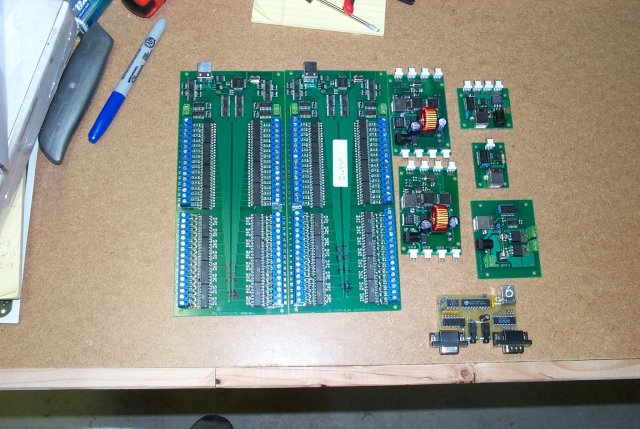 This originally was going to be a review of Phidgets.
After thinking about it, I decided instead to tell you what they are.
Phidgets really don't need "reviewing". It would be like reviewing a box
of Legos. A Phidget is a building block and stands on its own that way.
Pictured above is the set of Phidgets that I'm currently working with in the
F-15C cockpit.
From left to right:
0/32/32 Input/Output board (2)
8 Servo Phidget (2)
(top to bottom)
4 Servo Phidget
1 Servo Phidget
Power Phidget
Prototype 2/8/8 Phidget
If you think of a Phidget as a digital Lego with a USB connection, you won't be
far wrong.
This originally was going to be a review of Phidgets.
After thinking about it, I decided instead to tell you what they are.
Phidgets really don't need "reviewing". It would be like reviewing a box
of Legos. A Phidget is a building block and stands on its own that way.
Pictured above is the set of Phidgets that I'm currently working with in the
F-15C cockpit.
From left to right:
0/32/32 Input/Output board (2)
8 Servo Phidget (2)
(top to bottom)
4 Servo Phidget
1 Servo Phidget
Power Phidget
Prototype 2/8/8 Phidget
If you think of a Phidget as a digital Lego with a USB connection, you won't be
far wrong.
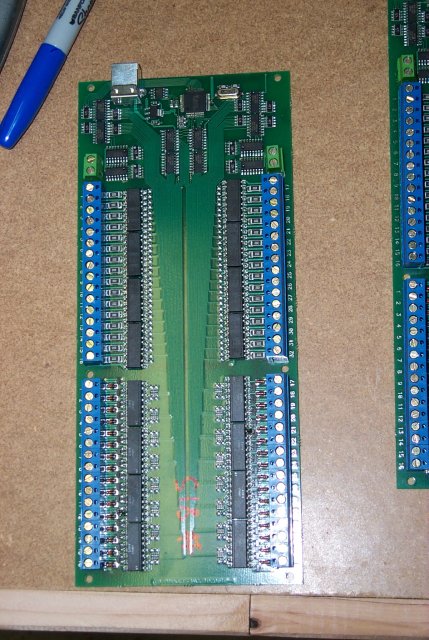 This is the "0/32/32" Phidget. The numbering system that is used indicates
what it does (for the most part). "0" indicates that it supports no analog
channels, while the "32" twice indicates it supports 32 digital inputs and
32 digital outputs.
Each Phidget has it's own unique serial number that is referenced when you
need to talk to a specific Phidget. In the case of the Phidget pictured here,
the serial number is 815. This particular Phidget is very useful to me for
both it's cost, usability and capability. Each output (and input for that
matter) is optically isolated to protect the Phidget. The outputs can sink
(handle) up to 250mA of power at up to 40VDC. This works out really well since
the majority of the indicator lights in the cockpit run at 24VDC.
You're not limited to driving just lamps either. Any device that you can
think of you can use, as long as it obeys the limits of the board. If you
try to draw too much power or supply greater than 40 VDC to the board, you'll
burn it up.
This is the "0/32/32" Phidget. The numbering system that is used indicates
what it does (for the most part). "0" indicates that it supports no analog
channels, while the "32" twice indicates it supports 32 digital inputs and
32 digital outputs.
Each Phidget has it's own unique serial number that is referenced when you
need to talk to a specific Phidget. In the case of the Phidget pictured here,
the serial number is 815. This particular Phidget is very useful to me for
both it's cost, usability and capability. Each output (and input for that
matter) is optically isolated to protect the Phidget. The outputs can sink
(handle) up to 250mA of power at up to 40VDC. This works out really well since
the majority of the indicator lights in the cockpit run at 24VDC.
You're not limited to driving just lamps either. Any device that you can
think of you can use, as long as it obeys the limits of the board. If you
try to draw too much power or supply greater than 40 VDC to the board, you'll
burn it up.
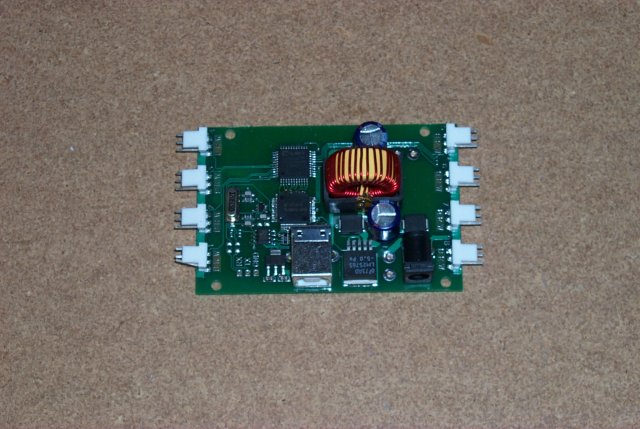 This is an 8 servo Phidget. It will control up to 8 servos like you'd find
in a radio controlled airplane. This phidget requires an external power
supply to drive the servos themselves. This is because the total draw of
8 servos exceeds what can safely be pulled from the Universal Serial Bus.
The bent pin on the lower right connector is due to my clumsy handling of the
Phidget, not Chester's quality control. :)
This is one of two Phidget servos that I will be using to drive the engine
gauges in the F-15. I have a total of 15 gauges that relate to either the
engines or hydraulic systems. These gauges are custom built by Marv De Beque
and are all driven by Futaba micro servos. A perfect fit!
Below are images of the 4 servo Phidget and the single servo Phidget. They're
functionally the same as the 8 servo Phidget.
This is an 8 servo Phidget. It will control up to 8 servos like you'd find
in a radio controlled airplane. This phidget requires an external power
supply to drive the servos themselves. This is because the total draw of
8 servos exceeds what can safely be pulled from the Universal Serial Bus.
The bent pin on the lower right connector is due to my clumsy handling of the
Phidget, not Chester's quality control. :)
This is one of two Phidget servos that I will be using to drive the engine
gauges in the F-15. I have a total of 15 gauges that relate to either the
engines or hydraulic systems. These gauges are custom built by Marv De Beque
and are all driven by Futaba micro servos. A perfect fit!
Below are images of the 4 servo Phidget and the single servo Phidget. They're
functionally the same as the 8 servo Phidget.
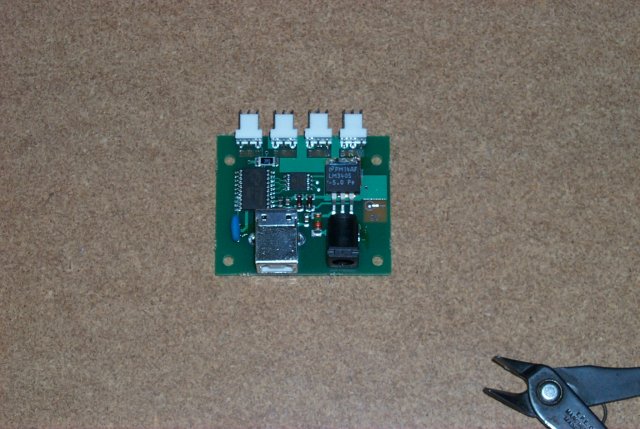 You'll note that the 4 servo Phidget also requires an external power supply.
You'll note that the 4 servo Phidget also requires an external power supply.
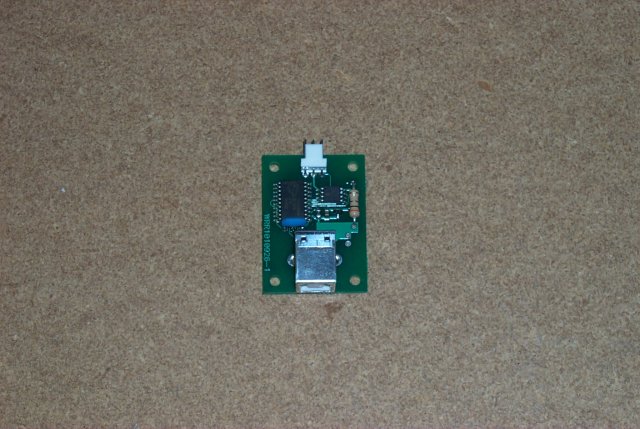 This is for just one servo. It's VERY small. The Phidget drives the servo
using the power available on the Universal Serial Bus.
This is for just one servo. It's VERY small. The Phidget drives the servo
using the power available on the Universal Serial Bus.
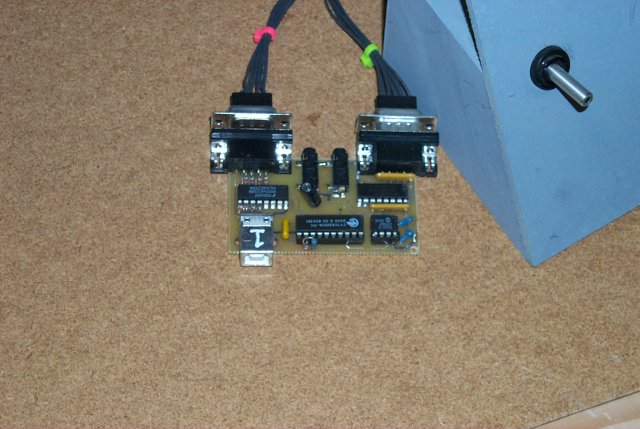 This is the first Phidget. As you can see, the serial number painted on the
USB connector is "1"! This particular unit is a 2/8/8 Phidget which means
that it will handle 2 analog inputs, 8 digital inputs and 8 digital outputs.
Here's a Power Phidget.
This is the first Phidget. As you can see, the serial number painted on the
USB connector is "1"! This particular unit is a 2/8/8 Phidget which means
that it will handle 2 analog inputs, 8 digital inputs and 8 digital outputs.
Here's a Power Phidget.
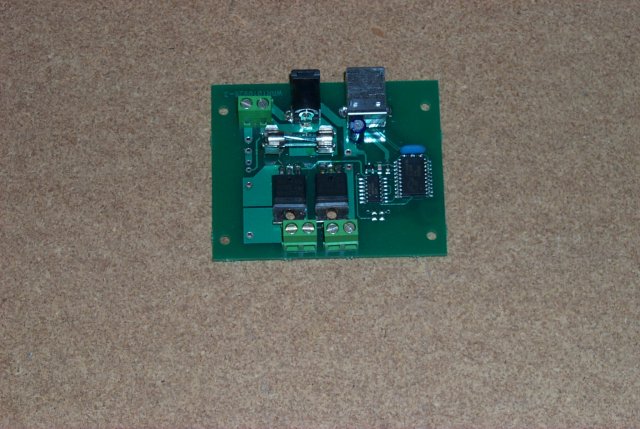 This device can provide a variable pulsed DC output for motor control, etc.
This Phidget would make a great vibration system controller for a cockpit.
As soon as I get the pictures taken, I'll show you what the new 64 LED/7
Segment Display controller looks like. It's very cool.
[27Jan03]
As promised, here are the pictures of the 64 LED/7 Segment controller:
This device can provide a variable pulsed DC output for motor control, etc.
This Phidget would make a great vibration system controller for a cockpit.
As soon as I get the pictures taken, I'll show you what the new 64 LED/7
Segment Display controller looks like. It's very cool.
[27Jan03]
As promised, here are the pictures of the 64 LED/7 Segment controller:
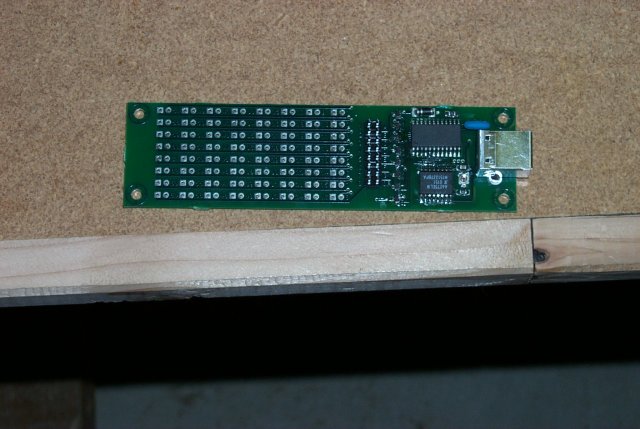 Next is an image of the brand new stepper motor controller. Chester informs
me that this will also control air-core motors. The black connectors on
each side are used for a "home" position detector.
Next is an image of the brand new stepper motor controller. Chester informs
me that this will also control air-core motors. The black connectors on
each side are used for a "home" position detector.
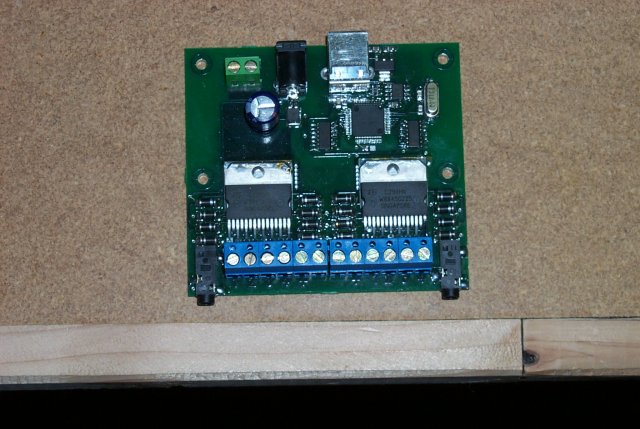 Phidgets can be found at
Phidgets can be found at
 This originally was going to be a review of Phidgets.
After thinking about it, I decided instead to tell you what they are.
Phidgets really don't need "reviewing". It would be like reviewing a box
of Legos. A Phidget is a building block and stands on its own that way.
Pictured above is the set of Phidgets that I'm currently working with in the
F-15C cockpit.
From left to right:
0/32/32 Input/Output board (2)
8 Servo Phidget (2)
(top to bottom)
4 Servo Phidget
1 Servo Phidget
Power Phidget
Prototype 2/8/8 Phidget
If you think of a Phidget as a digital Lego with a USB connection, you won't be
far wrong.
This originally was going to be a review of Phidgets.
After thinking about it, I decided instead to tell you what they are.
Phidgets really don't need "reviewing". It would be like reviewing a box
of Legos. A Phidget is a building block and stands on its own that way.
Pictured above is the set of Phidgets that I'm currently working with in the
F-15C cockpit.
From left to right:
0/32/32 Input/Output board (2)
8 Servo Phidget (2)
(top to bottom)
4 Servo Phidget
1 Servo Phidget
Power Phidget
Prototype 2/8/8 Phidget
If you think of a Phidget as a digital Lego with a USB connection, you won't be
far wrong.
 This is the "0/32/32" Phidget. The numbering system that is used indicates
what it does (for the most part). "0" indicates that it supports no analog
channels, while the "32" twice indicates it supports 32 digital inputs and
32 digital outputs.
Each Phidget has it's own unique serial number that is referenced when you
need to talk to a specific Phidget. In the case of the Phidget pictured here,
the serial number is 815. This particular Phidget is very useful to me for
both it's cost, usability and capability. Each output (and input for that
matter) is optically isolated to protect the Phidget. The outputs can sink
(handle) up to 250mA of power at up to 40VDC. This works out really well since
the majority of the indicator lights in the cockpit run at 24VDC.
You're not limited to driving just lamps either. Any device that you can
think of you can use, as long as it obeys the limits of the board. If you
try to draw too much power or supply greater than 40 VDC to the board, you'll
burn it up.
This is the "0/32/32" Phidget. The numbering system that is used indicates
what it does (for the most part). "0" indicates that it supports no analog
channels, while the "32" twice indicates it supports 32 digital inputs and
32 digital outputs.
Each Phidget has it's own unique serial number that is referenced when you
need to talk to a specific Phidget. In the case of the Phidget pictured here,
the serial number is 815. This particular Phidget is very useful to me for
both it's cost, usability and capability. Each output (and input for that
matter) is optically isolated to protect the Phidget. The outputs can sink
(handle) up to 250mA of power at up to 40VDC. This works out really well since
the majority of the indicator lights in the cockpit run at 24VDC.
You're not limited to driving just lamps either. Any device that you can
think of you can use, as long as it obeys the limits of the board. If you
try to draw too much power or supply greater than 40 VDC to the board, you'll
burn it up.
 This is an 8 servo Phidget. It will control up to 8 servos like you'd find
in a radio controlled airplane. This phidget requires an external power
supply to drive the servos themselves. This is because the total draw of
8 servos exceeds what can safely be pulled from the Universal Serial Bus.
The bent pin on the lower right connector is due to my clumsy handling of the
Phidget, not Chester's quality control. :)
This is one of two Phidget servos that I will be using to drive the engine
gauges in the F-15. I have a total of 15 gauges that relate to either the
engines or hydraulic systems. These gauges are custom built by Marv De Beque
and are all driven by Futaba micro servos. A perfect fit!
Below are images of the 4 servo Phidget and the single servo Phidget. They're
functionally the same as the 8 servo Phidget.
This is an 8 servo Phidget. It will control up to 8 servos like you'd find
in a radio controlled airplane. This phidget requires an external power
supply to drive the servos themselves. This is because the total draw of
8 servos exceeds what can safely be pulled from the Universal Serial Bus.
The bent pin on the lower right connector is due to my clumsy handling of the
Phidget, not Chester's quality control. :)
This is one of two Phidget servos that I will be using to drive the engine
gauges in the F-15. I have a total of 15 gauges that relate to either the
engines or hydraulic systems. These gauges are custom built by Marv De Beque
and are all driven by Futaba micro servos. A perfect fit!
Below are images of the 4 servo Phidget and the single servo Phidget. They're
functionally the same as the 8 servo Phidget.
 You'll note that the 4 servo Phidget also requires an external power supply.
You'll note that the 4 servo Phidget also requires an external power supply.
 This is for just one servo. It's VERY small. The Phidget drives the servo
using the power available on the Universal Serial Bus.
This is for just one servo. It's VERY small. The Phidget drives the servo
using the power available on the Universal Serial Bus.
 This is the first Phidget. As you can see, the serial number painted on the
USB connector is "1"! This particular unit is a 2/8/8 Phidget which means
that it will handle 2 analog inputs, 8 digital inputs and 8 digital outputs.
Here's a Power Phidget.
This is the first Phidget. As you can see, the serial number painted on the
USB connector is "1"! This particular unit is a 2/8/8 Phidget which means
that it will handle 2 analog inputs, 8 digital inputs and 8 digital outputs.
Here's a Power Phidget.
 This device can provide a variable pulsed DC output for motor control, etc.
This Phidget would make a great vibration system controller for a cockpit.
As soon as I get the pictures taken, I'll show you what the new 64 LED/7
Segment Display controller looks like. It's very cool.
[27Jan03]
As promised, here are the pictures of the 64 LED/7 Segment controller:
This device can provide a variable pulsed DC output for motor control, etc.
This Phidget would make a great vibration system controller for a cockpit.
As soon as I get the pictures taken, I'll show you what the new 64 LED/7
Segment Display controller looks like. It's very cool.
[27Jan03]
As promised, here are the pictures of the 64 LED/7 Segment controller:
 Next is an image of the brand new stepper motor controller. Chester informs
me that this will also control air-core motors. The black connectors on
each side are used for a "home" position detector.
Next is an image of the brand new stepper motor controller. Chester informs
me that this will also control air-core motors. The black connectors on
each side are used for a "home" position detector.
 Phidgets can be found at
Phidgets can be found at